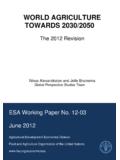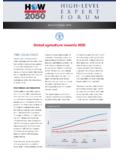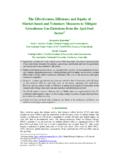Transcription of Modern Agriculture and Its Benefits- Trends, …
1 Modern Agriculture and Its Benefits Trends, Implications and Outlook Dr. William C. Motes Modern Agriculture and Its Benefits- Trends, Implications and Outlook Pre-publication draft, 3-16-10 | Page | 2 I. Perspective Meeting Society s Food Needs A Look Ahead to Mid-Century Renewable Fuels A New Dimension II. Considering Productivity III. What is Modern Agriculture ?..10 IV. Why Agricultural Progress is V. A New Challenge Updating the Social VI. Agriculture s Second Debate VII. Benefits of Modern Agriculture The VIII.
2 Observations Looking to the IX. Modern Agriculture and Its Benefits- Trends, Implications and Outlook Pre-publication draft, 3-16-10 | Page | 3 This section examines the benefits of Modern -day Agriculture a task made necessary by the fact that an increasing share of the population has little connection to farms or rural areas and thus little opportunity to understand the nature of farming, especially the Modern advances that are both helping to better feed the world s people and better protect the environment. Perhaps the chief paradox of Agriculture s abundance is the fact that many of its enormous successes are providing the basis for new challenges.
3 Chief among these, of course, is pressure from growing populations and increasingly wealthy developing-country consumers who want higher quality diets. To meet food demand expected by 2050, the sector must boost its capacity significantly in a relatively short period of time so that output grows by perhaps 70 percent or more over the next four decades, meets continuing future challenges in terms of protecting the environment and dealing with changing climates and does all this within a new economic and social setting a growing competition for resources from urban, infrastructure and industrial users.
4 And, it faces increasingly urgent constraints on the size and intensity of its environmental footprint. This section precedes a description of what are often seen as missteps made as the sector has evolved and modernized. These involve concerns about environmental degradation, exposure to health hazards from food contaminants, animal abuses and many other real and perceived problems, including increasing economic concentration across the value chain to the detriment of smaller family-oriented operations and rural areas. This drumbeat of criticism has seeped into the public consciousness in many cases and created a perception of a food system no longer held in high esteem by the general public despite the enormous benefits it has delivered over time.
5 In spite of such criticisms, the section argues that global Agriculture is on track to accomplish its main goals within numerous important, new constraints but that it remains vulnerable to inappropriate priorities and policies. Thus, it describes key challenges that extend both to the sector and to the general public including, especially, opinion leaders and policymakers. Its purpose is to help readers reach more fully informed views about Agriculture , its needs, its objectives and the policies that should govern it. In 1798, English philosopher Thomas Malthus famously argued that food production growth is inevitably limited by physical resource availability while population growth is geometric in its nature.
6 He saw the food-population balance as always precarious because of physical resource limitations and the arithmetric growth 1 Thomas Malthus, An Essay on the Principle of Population, 1798, Chapter 1. Modern Agriculture and Its Benefits- Trends, Implications and Outlook Pre-publication draft, 3-16-10 | Page | 4 Malthus thought this contrast must lead inevitabily to declining food availabiliy that at subsistence levels would threaten health and constrain fertility. Even when a population habitat was new such as the American continent at that time, or when recovering from wars or epidemic plagues, he expected population to reach the limit of its resource base, and to do so relatively rapidly.
7 world leaders widely accepted the Malthusian inevitability for many years but more recently have focused anti-malthusian policies in at least two directions. First, new social patterns have made population growth less relentlessly geometric, especially in Europe, the United States, and parts of Asia but elsewhere, as well. The world now expects continued growth, but at a slower pace. Global numbers are expected to grow from billion in 2005 to a stable plateau of billion by 2050, far below the path Malthus perceived, which would have meant more than 14 billion by 2050 without the intervention of disease or famine.
8 In addition, food production growth is no longer seen as tightly constrained even though many production resources are fixed, or nearly so, as Malthus correctly perceived including land and water. Since the 1950s, and especially over the last four decades, advances in output have been sufficient to support better and more secure diets for most of the world s people although not for all, reflecting distribution problems rather than supply inadequacies. For example, since the 1970s, as Agriculture became increasingly Modern , grain and oilseed production more than doubled an increase of more than one billion tons while planted area grew only modestly (Charts 1 and 2).
9 Without this Modern productivity, global output levels achieved last year would have required nearly 60% more land than actually was cropped. While the necessity of breaking Malthus iron geometric-arithmetic link is widely understood and generally applauded, the means to that objective are frequently misunderstood. On the one hand, there is mounting evidence that the skillful application of science can allow the global population to better control its own development and growth. However, there also are powerful advocates of constraint for key aspects of Modern systems policy paths that, if adopted would have significant, negative implications for many of the world s people.
10 Modern Agriculture and Its Benefits- Trends, Implications and Outlook Pre-publication draft, 3-16-10 | Page | 5 Chart 1. Global Grain Production, Consumption and Stocks, 1970-2008 Chart 2. world Grain and Oilseed Production, With and Without Yield Advances since the 1980sSource: Informa Economics The main driver of global food demand in the future is the expanding purchasing power of middle-class populations in developing countries who are demanding higher quality diets. This trend has become especially important now as agricultural resource limits tighten at the same time competition for the same resources grows among urban, infrastructure and industrial users.




